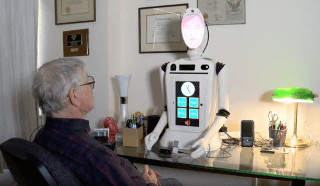Oct 27 2017
With the life expectancy of Americans increasing, the number of people dealing with Alzheimer’s and dementia continues to grow. A serious hardship these patients face is a lack of caregivers. The Bureau of Labor Statistics estimates that in the following five years, more than 1 million caregivers will be required to care for the elderly.
 David Keir interacts with Ryan in his home. (Credit: University of Denver)
David Keir interacts with Ryan in his home. (Credit: University of Denver)
Helping to meet the challenge is Ryan, a companion robot being built by Associate Professor Mohammad Mahoor and Students in the Daniel Felix Ritchie School of Engineering and Computer Science.
The purpose of Ryan is to use technology, especially robotics technology, to assist people. Ryan is going to help people in terms of social interaction — those who are lonely, those who need support, and those who need a companion.
Mohammad Mahoor, Associate Professor, Daniel Felix Ritchie School of Engineering and Computer Science
Ryan is engineered to assist the aging population, specifically those suffering with Alzheimer’s. Ryan is equipped with artificial intelligence technology and is programed with cognitive games that help keep the brain active. The robot can identify who it interacts with and hold conversations.
“Ryan can read people’s emotions through their facial expressions and then mimic it back,” Mahoor says. “Ryan is an empathic robot, meaning that empathy is part of her character to support people socially and emotionally.”
Ryan is now being tested by senior citizens residing at Kavod Senior Life in Cherry Creek.
You never quite know where a conversation is going to lead. When I get up in the morning, she says, ‘be sure to have a good breakfast.’ She will remind me to be safe and remind me that it’s time to clean up my room, but she doesn’t scold me too bad.
David Keir, Resident, Kavod Senior Life
Mahoor and his team are gathering data and analyzing how seniors interact with the robot. This information is being used to enhance the next iteration of Ryan, which will include movable arms to help train seniors on how to be more active.
“It’s amazing,” Keir says of Ryan. “When I was a kid, like 70 years ago, I was reading science fiction stories about Ryan. So this is like being in a science fiction story.”
The goal in the following two years is to further develop the technology and have a manufacturer mass-produce Ryan. The robot would then be made available to consumers via a subscription basis, so that people can have Ryan for only the time that they need it.
The idea is to use technology and develop technology that can help people on a daily basis. We don’t want technology to just sit in labs. We want ordinary people to be able to use and benefit from tech nology.
Mohammad Mahoor, Associate Professor, Daniel Felix Ritchie School of Engineering and Computer Science
Companion Robot for Alzheimer's Patients | University of Denver